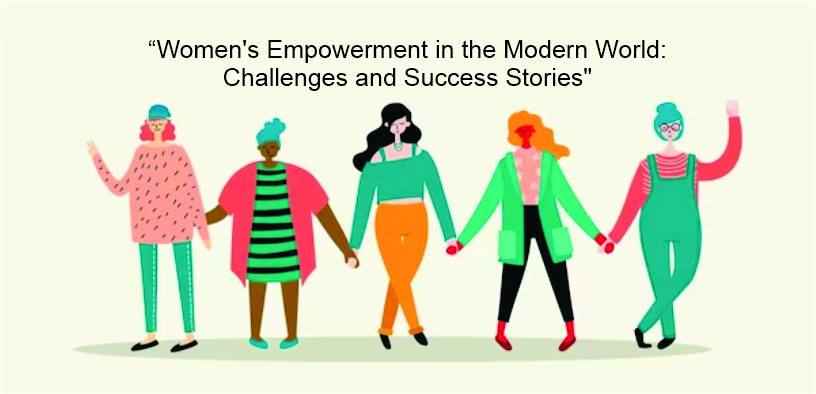Women’s empowerment is a critical issue in the modern world, aiming to provide equal rights, opportunities, and autonomy to women across various spheres of life. It is a multidimensional concept that encompasses social, economic, political, and cultural aspects.
Despite significant progress in recent decades, there are still numerous challenges that hinder the full realization of women’s empowerment. However, Narayan Seva Sansthan has played a crucial role in empowering women and improving their lives.
I. Challenges to Women’s Empowerment:
A. Gender Stereotypes and Societal Expectations:
Deep-rooted gender stereotypes and societal expectations limit women’s opportunities and perpetuate traditional roles, preventing them from reaching their full potential.
B. Unequal Access to Education and Healthcare:
Disparities in education and healthcare access hinder women’s development, leading to limited career prospects and health outcomes.
C. Economic Inequality and Gender Pay Gap:
Women often face wage disparities and limited economic opportunities, impeding their financial independence and contribution to society.
D. Violence Against Women:
Gender-based violence, including domestic abuse, sexual harassment, and human trafficking, poses a significant threat to women’s safety and empowerment.
II. Success Stories in Women’s Empowerment:
A. Education and Leadership:
Highlighting success stories of women who have broken barriers in education and leadership positions, becoming role models for future generations.
B. Entrepreneurship and Economic Empowerment:
Showcasing women entrepreneurs who have succeeded in various industries, promoting economic empowerment and women-led businesses.
C. Advocacy and Legal Reforms:
Exploring stories of activists and organizations that have brought about positive change through advocacy and legal reforms, ensuring women’s rights are protected and upheld.
D. Health and Well-being:
Sharing success stories of initiatives that have improved women’s access to healthcare, promoting overall well-being and reducing maternal mortality rates.
III. Innovations and Technology for Women’s Empowerment:
A. Access to Information and Digital Literacy:
Discussing how access to information and digital literacy programs have empowered women, enhancing their skills and enabling economic opportunities.
B. Mobile Technology for Empowerment:
Examining how mobile technology has transformed women’s lives, from mobile banking to health applications, bridging gaps in education and healthcare.
C. Women in STEM:
Celebrating women’s accomplishments in science, technology, engineering, and mathematics (STEM), and encouraging more women to pursue careers in these fields.
IV. Global Initiatives and Collaborative Efforts:
A. United Nations Sustainable Development Goals (SDGs):
Highlighting how the UN’s SDGs play a crucial role in promoting women’s empowerment and gender equality on a global scale.
B. International Women’s Day and Women’s Movements:
Recognizing the impact of international days like International Women’s Day and the collective efforts of women’s movements in driving change.
C. Corporate Initiatives and Gender Diversity:
Showcasing companies that have implemented gender diversity programs, fostering inclusive workplaces that empower women.
V. Overcoming Cultural Barriers to Women’s Empowerment:
A. Breaking Taboos and Challenging Norms:
Examining how women and communities have challenged cultural taboos and norms that limit women’s choices, paving the way for social change and empowerment.
B. Empowering Voices through Arts and Media:
Exploring how art, literature, and media platforms have become powerful tools to amplify women’s voices and raise awareness about women’s issues.
C. Role of Religious and Community Leaders:
Discussing success stories of religious and community leaders who advocate for women’s rights and gender equality, fostering a more inclusive and accepting society.
VI. Women’s Empowerment and Environmental Sustainability:
A. Women as Climate Change Champions:
Recognizing the significant role women play in environmental conservation and sustainable development, showcasing their contributions as climate change champions.
B. Sustainable Livelihoods for Women:
Examining initiatives that empower women in rural areas through sustainable livelihood opportunities, promoting environmental preservation and economic empowerment.
C. Addressing Gender and Climate Intersectionality:
Analyzing the intersectionality of gender and climate, and how addressing gender disparities can lead to more effective climate change solutions.
VII. Supporting Marginalized Women:
A. Indigenous Women’s Empowerment:
Shedding light on the unique challenges faced by indigenous women and the efforts to empower them, respecting their cultural identity and rights.
B. Empowerment for Women with Disabilities:
Showcasing initiatives that promote accessibility and inclusivity for women with disabilities, enabling them to participate fully in society.
C. Refugee and Migrant Women Empowerment:
Highlighting the resilience of refugee and migrant women and the programs that support their empowerment and integration in new communities.
VIII. Men as Allies in Women’s Empowerment:
A. Changing Perceptions and Challenging Patriarchy:
Recognizing the importance of engaging men and boys as allies in dismantling patriarchal norms and promoting gender equality.
B. Fathers’ Role in Empowering Daughters:
Illustrating success stories of fathers who actively support and encourage their daughters’ ambitions, contributing to a more empowered next generation.
IX. Empowering Women in Conflict Zones:
A. Women’s Participation in Peacebuilding:
Examining how women’s active involvement in peace negotiations and conflict resolution enhances the prospects of lasting peace.
B. Supporting Women in Post-Conflict Reconstruction:
Showcasing initiatives that provide women in conflict-affected regions with resources and opportunities for rebuilding their lives and communities.
X. Future Prospects and Call to Action:
A. Leveraging Technology for Greater Impact:
Discussing the potential of emerging technologies like artificial intelligence, blockchain, and virtual reality in advancing women’s empowerment.
B. Strengthening Global Collaborations:
Emphasizing the need for continued cooperation among governments, NGOs, corporations, and individuals to accelerate progress towards gender equality.
C. Investing in Girls’ Education and Leadership:
Advocating for increased investment in girls’ education and leadership development, recognizing it as a crucial step towards a more empowered future.
Conclusion
Women’s empowerment is an ongoing global endeavor, with challenges to overcome and inspiring success stories to celebrate. Despite the obstacles, organizations like Narayan Seva Sansthan play a crucial role in addressing the unique challenges faced by women with disabilities and creating a more inclusive and equitable world.








